Russian-born Adolph Yudalevich, refugee from the viciously anti-Semitic czarist regime, landed in America in 1883 at the age of 8 where he became the future American doughnut tycoon Adolph Levitt. As an early 20th-century business magnate, he was a late bloomer. Levitt was in his late 40s by the time he made coffee and doughnuts part of the American way of life when he invented the doughnut machine. And the rest is doughnut history. —

He also gets credit for the simple and more marketing-friendly spelling of donut, which stuck immediately after Levitt started his company, The Donut Corporation of America, in the 1920s, and remains the industry standard today. Imagine if Dunkin’ Donuts had been called Dunkin’ Doughnuts. It just looks wrong.
Levitt and Phil’s forebears had much in common as paradigms of the American immigrant tale, with all its fluctuations. Phil’s grandpa Louis Ball and Adolph Levitt, generational peers, both found themselves in the land of the free as a result of oppression at the hands of the Jew-hating czars and citizenry of Mother Russia. Ten years older than Levitt, Louis was not about to spend 25 years in the Russian army like so many other young Jewish men in Poland at the time. He was 24 in 1890 when he fled to the America and built a thriving and respected kosher butcher shop and business in Newark. Levitt, arriving in Milwaukee as a child, had more time to get accustomed to his new country before amassing a multifaceted fortune in the ensuing decades.

Phil’s great-grandfather Pinchas was nearing 60 when he immigrated to the United States in 1903 to tend to his fatally ill oldest child and daughter, Chana. Eventually, with the help of his son-in-law Louis, the Rissman patriarch brought her four sisters to that better way of life sought by some 20 million immigrants to the United States from Southern and Eastern Europe from 1880 to 1920. Like Pinchas, Levitt’s mother and father certainly had the future of their eight children in mind on their New World journey.
Like Phil’s pop, who was taken out of grade school to deliver meat with his brother from a horse-drawn wagon, Levitt had to quit school at 10 to help his brother, a peddler, scrape up pennies by selling newspapers in brothels. Their mother had become a penniless widow unable to support her huge brood of kids after Levitt’s father died a year after the family immigrated. The learned by reading encyclopedias. Both Adolph Levitt and Morris Ball failed again and again in business. Phil’s dad, born two decades after Levitt, in 1895, an unlucky generation, got zapped by the Great Depression. As a man in his 30s with a wife and child, facing the most devastating period of impoverishment the United States has ever known, Morris’ final butcher shop bankruptcy spelled the end of his self-sufficiency, landing him in the humble Jersey City candy store that at first he couldn’t even call his own.
Levitt on the other hand, left his wreckage behind in Milwaukee in 1912 and at age 37 went to New York City. As the saying goes, if you can make it there, you can make it anywhere. And there is where America’s love affair with doughnuts became the driving force in Levitt’s American dream story.
The roots of that great romance run deep. Here’s how it all began.
a brief history of the donut
In a 1998 story in Smithsonian Magazine about the doughnut’s rise to popularity in the culinary day-to-day lives of Americans, David A. Taylor wrote: “It is true that the humble doughnut does have a convoluted past that involves Dutch immigrants, Russian exiles, French bakers, Irving Berlin, Clark Gable and a certain number of Native Americans. And, yes, in its democratic ethos, its optimism, and its assorted origins, it does seem rather quintessentially American.
“Of course doughnuts in some form or other have been around so long that archaeologists keep turning up fossilized bits of what look like doughnuts in the middens of prehistoric Native American settlements.”

Uncountable curious researchers have delved deeply into the convoluted origins of the doughnut. Fried dough is a universal independent invention found in some form or the other in nations, regions and cultures throughout the world. Tracing the birth of the tasty cylinders with an airy middle that we relish today requires a journey back to the 1600s and the Dutch settlers of New Amsterdam—later Manhattan. Those hearty pioneers loved them some olykoeks, literally “oily cakes” of sweetened dough fried up in hog’s fat. Washington Irving mentioned these delightful comestibles in his book A History of New York, in which he first called them “dough-nuts,” possibly an adaptation of dough knots, a common alternate term for the delectable enjoyed back then mainly by the Dutch.
So just who made the doughnut into a ring? Jump ahead a couple hundred years and the lore acquires two new characters in the mid-19th century. New England ship captain Hanson Gregory apparently liked to travel the high seas with his mother, Elizabeth, onboard. Hanson’s mom was a clever and resourceful woman who made the most of the ship’s limited supplies by frying up dough cakes for the crew and filling the softer middle that took too long to get firm with hazelnuts and walnuts. This legend has Elizabeth Gregory giving her creation the literal name doughnut.

Adolph Levitt’s granddaughter Sally Steinberg Levitt, aka the Donut Princess, author of The Donut Book, a lighthearted encyclopedia of fun facts, remembers her grandfather telling of the American ship captain who invented the modern doughnut in 1847 by affixing his cake onto a spoke handle of the ship’s wheel during a storm. Hanson Gregory indeed claimed credit for making “the first doughnut hole ever seen by mortal eyes” by cutting out the nutty center with the top of a round pepper tin and skewering it on a wheel spoke so he could steer through the choppy waters of the North Atlantic with both hands.
Ironically, it was war that truly whetted the American appetite for the peace, comfort and satisfaction of the doughnut.
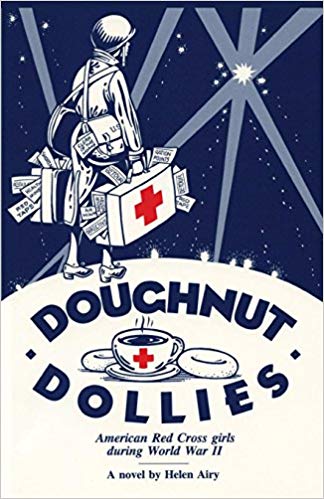
During World War I, two Salvation Army ladies, whose mission would be taken up by Red Cross women known as Donut Dollies during the Second World War, started it all when they took to frying ’em up in batches and actually delivering doughnuts to the boys on the front lines. They were quite the hit. The delicious treats—cheaper and much easier to make than pies and cakes—caught on big-time. Soldiers returned home with a taste for this comfort food forged in battle, and before long the hankering spread across the land. By the 1920s, House Beautiful magazine proclaimed ‘”the epitome of domestic bliss and family welfare, frying doughnuts.”
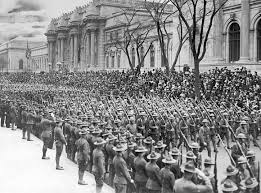
The stage was set for Levitt’s particular brand of good old-fashioned Yankee ingenuity to seize on this business opportunity.
A perpetual entrepreneur, Levitt had opened department stores—store after store after store—in Milwaukee, only to see them go belly up again and again and again. He was broke when he made a fresh start in New York City, helping out with a bakery chain. When Levitt started frying doughnuts in a kettle in his Harlem bakery, passersby would push up against the window to watch, presaging great things to come. However the fumes from the process started to bother moviegoers next door, and that gave Levitt the idea to build a doughnut machine. That and the law of supply and demand.
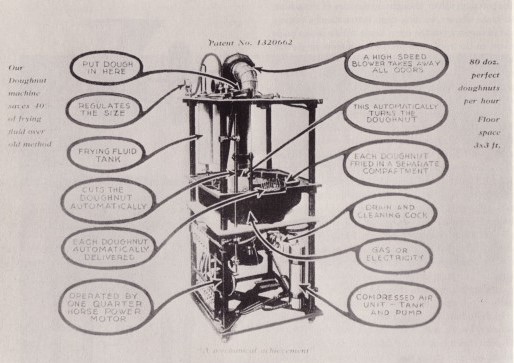
According to Levitt’s granddaughter, Levitt met the engineer who would help him devise such a contraption on a train. In this endeavor, as always, Levitt persevered. The indefatigable duo built 11 machines that went kaput. Finally, in 1921, on their 12th try, they produced “The Amazing Almost Human Automatic Donut Machine.” It worked.
“My grandfather put it in the window of his bakery and became the doughnut king overnight. He multiplied the cake with the hole, part of the New World he had come to, until just about everyone had coffee and doughnuts for breakfast,” Steinberg wrote in a 1981 article for The New York Times.
Many such machines—of ever-increasing efficiency and doughnuts-per-minute—would follow. In 1997, Krispy Kreme donated the Ring King Jr., an odd metal apparatus about 5 feet high that was once America’s most advanced doughnut maker, to the Smithsonian Institution, keeper of the vast archive of American history and technological prowess in the nation’s capital. The doughnut and coffeehouse chain, which got its foothold in the South nearly two decades after Levitt paved the way, has its own uniquely American history starting with, as usual, a humble origin.
A down-on-his-luck Frenchman named Joe LeBeau made his way up from New Orleans to Paducah, Kentucky, during the Depression where the hard times forced him to sell his secret recipe and the name Krispy Kreme, to a local store owner named Ishmael Armstrong, who hired his nephew, Vernon Rudolph, and put him to work selling the treats, baked from a recipe LeBeau had written down on a piece of paper, door-to-door . In 1936, the same year a popular song declared that you can live on coffee and doughnuts if “you’re in love,” young Vernon and a couple of friends started selling their doughnuts out of the back of a Pontiac, the dawn of a business that almost 85 years later pulls in about $520 million a year in revenue and has franchises throughout the world.
Levitt’s invention made it all possible. Taylor, an expert in the history of science in the United States, described it in Smithsonian Magazine: “There before them a circle of dough, shaped like a perfect smoke ring, and about the diameter of a baseball, dropped off into a vat of boiling oil, circulated, got turned over to brown on the other side, and emerged from the oil on a moving ramp, one by one like ducks in a row.”
Although by some accounts doughnut machines had already been on the market by the time Levitt unveiled his in an unprecedented PR extravaganza. None took the public by storm quite like this one, which is why he’s gone down in history as its inventor.

Ten years after its invention, when Levitt moved the doughnut machine spectacle, appropriately, to the Big Apple’s Theater District in Times Square, the Broadway crowds literally ate it up. Traffic stopped. Throngs gathered to watch, and learn, how the hole in doughnut was not punched out, but built in. And the irresistible aroma combined with the vision through a wide glass window of doughnuts marching down a shiny conveyor belt and stacked up on racks was all the advertising that was needed. It was enough to make one “half swoon at the warmth and sweet vanilla richness of it all,” Taylor reminisced.
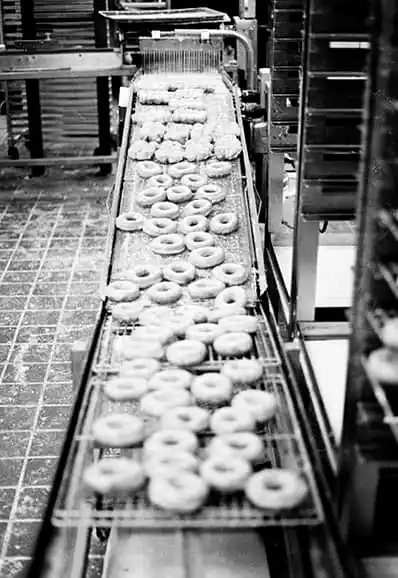
For a time the corner of Broadway and 45th Street was dubbed Donut Corner. Phil remembers taking in the scene: “If you went to Times Square, there was a popular restaurant owned by Jack Dempsey, the Irish-American former heavyweight boxing champ. And right next door in the window you had one of these miniature doughnut machines. Dough would drop out of a hopper onto a turntable that went through fat and it could fry doughnuts in front of you.”
It’s always been a foodstuff eschewed by serious chefs and diametrically opposed to haute cuisine; therefore doughnuts and their makers and purveyors have never taken themselves too seriously. With diverse and multicultural roots, brought to the people by underdogs, it was an eminently approachable snack that “represented the democratization of food,” according to Taylor.
In an old book of curious facts, Steinberg found one that claimed the average American eats two doughnuts a day. As the decades have progressed, particularly through the thinness-obsessed ’80s and ’90s, the ire of nutritionists who assail their high fat and sugar content—with a walloping 190 to more than 400 calories a pop (depending on your poison)—that purported consumption rate has gone way down; the average American today eats 31 donuts a year, or two or three a month. But no amount of scolding or scorn can keep the more than 25,000 donuts shops across our nation from serving more than 10 billion donuts each year at a hefty profit as always thanks to the inexpensive ingredients required.
Back in the 1920s, Levitt’s paradigm-changing innovation turned doughnut making into automation, so it immediately became associated with the wave of the future brought about by machines, foremost in people’s minds in that forward-looking Art Deco era with its unbridled optimism. Even after the stock market crash in 1929, when the optimism dissolved into despair, doughnuts, at 5 cents apiece, were accessible to even the Depression’s most beleagured victims. And Levitt’s marvelous machine continued to be yet another symbol of American advancement and hope that the country could recover from the hard times.

In a 1931 piece, The New Yorker enthused, “Doughnuts float dreamily through a grease canal in a glass enclosed machine, walk dreamily up a moving ramp, and tumble dreamily into an outgoing basket.”
By this time the dreamy snack had Levitt living his own dream, to the tune of $25 million a year, which his Donut Corporation of America was earning, mostly from wholesale delivery to bakers across the United States. Taylor noted how ” a company spokesman breathlessly reported that Levitt’s machine had pulled the doughnut ‘out of the mire of prejudice that surrounded the heavy, grease-soaked product … and made it into a light, puffy product of a machine.’ “
Doughnuts were so popular that, during the Chicago World’s Fair of 1934, they were called the “hit food of the Century of Progress.”
An old song goes, “Who made the doughnut with the doughnut with the hole in the middle? Just how it got there will always be a riddle.”
It’s a rich history riddled with diverging paths and controversy, but there’s no riddle when it comes to who brought the doughnut with the hole in the middle to the masses: His name was Adolph Levitt.
how to double your salary, and Then some
By the time Phil landed a job there in 1954, The Donut Corporation of America, or DCA, as it was known, had firmly established itself in as one of the leaders in the business of doughnuts and their makings.
It was just a about a year before Levitt would die, in 1955. Phil never met the ingenious immigrant who founded the company but … [STORY ABOUT CONVERSATION IN A TAXICAB WITH SON DAVID.]
His life and times at DCA would become the most colorful and crazy of Phil’s early professional career, during the 1950s, a decade rife with optimism and opportunity in America. However a position as salesman and marketing strategist extraordinaire for DCA hadn’t just fallen into Phil’s lap. It didn’t become the next step on his way to a six-decade career in finance and investment at the highest level without renewed hustle on his part. By the summer of ’53, when Bobby was born, he and Phyllis were still in their “moldy” two-room Jersey City pad, and Phil’s Eversharp career was drying up,
“As a junior salesman, I had the territory from Jersey City down to Lakewood. Another man from the group, Bob Gilmartin, had the territory north, up through Rockland County and New York State,” Phil recalled. “My territory had very little business. Eversharp did not have good distribution is this part of Jersey, and I was doing poorly. I knew I wasn’t knocking out records. I went to the management at Eversharp and I said, ‘Ya know, I’m in a bad territory here. And I have ability. I want a better territory.’ “
When their salesman in Albany quit, Eversharp managers offered Phil that beat. But that was a deal breaker. “They told me Albany’s open, you can go up there. Bu I didn’t want to relocate and Phyllis didn’t want to either. We were in Jersey City, my folks were in Jersey City, and she was from Bayonne. So I stalled and I started looking for a better job.”

It was more than just a job hunt. Phil set out on a path to improving himself as well as his prospects, and that included rewriting his résumé . And he wasn’t afraid to ask for help. In the immediate wake of the Korean War, President Eisenhower took office in 1953 and extended the generous and grateful largess of the G.I. Bill to veterans of that conflict. “America was still in this postwar period and the Advertising Council of New York set up an effort to help the GIs get back into the business world—a job-finding forum—and they recruited people from companies, successful people.”
The meetings were held in a New York City church, which was appropriate. “They would teach you, but they would also preach: You can find the job you want. But first you have to define what you want to do and then you have to write a résumé and develop a portfolio to demonstrate to an employer that you can fill the jog you’re telling him that you can do.”
Phil started regularly attending their meetings at night, and Phyllis went with him. The program was tailor-made for Phil, always a great fan of research and reconnoitering, never a guy who liked to go into anything cold. The first thing they taught him to do was to scout out an employer who had a job available with the function he wanted to fill. “I always wanted to be an advertising executive or a marketing manager but I wanted to do creative work and be in a developmental end of a job,” Phil said. He learned how to write not a chronological résumé, but a functional one.
“In a functional résumé, you introduce yourself to the position. I wanted to be a product manager. So if you go to, say, Colgate or Procter & Gamble—they had many many products. Well, each of those products is run by one person who’s like the president of that product,” Phil explained, “and that’s what I felt I was suited for because I had this very wide, diversified experience at NYU. I had a basic accounting course. I had a basic management course. I had a course in advertising and packaging. I knew a lot about this particular function, so I wrote a résumé to qualify as a product manager.”
Phil followed directions and came up with a summary that broke down the functions of being a product manager and then forcefully presented his qualifications through his relevant past experience at Eversharp—specific examples of why he did it well and the percentage of increase he’d had as a salesman. “You didn’t just give generalities, Phil stressed, “you gave very specific examples. And with that, then, I developed a portfolio with pictures, like the one G.C. Murphy had taken of the razor blade buildup I spearheaded. It illustrates my capability well. I developed a very effective little portfolio and résumé to start looking for a job. And it was one of these employment agencies that looked at it and said, hey, ya know you might be good for DCA. They’re looking for a marketing manager, a marketing executive. And that’s how I got there.”
Phil had some firsthand experience that would serve him well in securing his position as star salesman for DCA and eventually an ambassador for the dunking of doughnut to the nation’s children and grownups alike. “I always got excited when I could apply to a company that I knew about,” he said. “When I was in the Army with Jimmy Sanfilippo, the two of us would go off on passes on weekends in Washington, D.C. We used to go to a Mayflower Coffee Shop. First we’d go to the Salvation Army and get free biscuits and then we’d go to the Mayflower and hang out for the night. We never had any money, so we’d have a weekend in Washington and spend no money.”

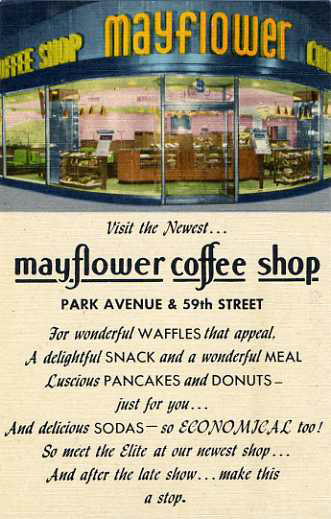
What better name for a the bakery and coffee chain established by an immigrant who found success in America after fleeing religious persecution in the Old Wold than Mayflower. Adolph Levitt opened his first Mayflower Coffee Shop in 1931 in Times Square a decade after putting his doughnut machine to work there and incorporating DCA. This flagship cafe and bakery was followed by one each in Boston and Chicago the next year, and another in Springfield, Massachusetts, in 1934. By 1936 there were 15 around the country, and in 1949 there were 24.
Emblazoned on the front each box of doughnuts Mayflower sold (as well as on plaques adorning the coffee shops’ walls) customers found Levitt’s motto, The Optimist’s Creed:

“As you ramble on through life, brother,
Whatever be your goal,
Keep your eye upon the doughnut
And not upon the hole.”
Flanked on the package by two jesters—a sad one focused on a doughnut that’s mostly hole and his glass-half-full ,happy counterpart—Levitt’s granddaughter told The New York Times that he had found the quaint rhyme framed in a dime store, and decided then and there to make it his personal creed. The digital news site Extra Crispy, devoted entirely to articles about breakfast and brunch, pointed out that while Mayflower Coffee Shops were the Dunkin’ Donuts of their day, as a tagline, Levitt’s motto offered “a much more elaborate and inspirational”—not to mention less self-serving—tagline than “America Runs On Dunkin’.” Back in the ’30s, as Americans dug in for the Depression, Levitt’s Pollyanna-ish message may have been a bit harder for people to swallow than the delicious doughnuts inside the package, but for the fresh-faced and rosy peacetime of the mid-1950s, with former soldiers and their families prospering with a big boost from the government, The Optimist’s Creed was a philosophy all but the grouchiest people could live by.

If there’s one thing that characterized this young salesman’s personality, it was optimism. The grandson of Jewish immigrants like the one who made DCA happen, and having endured a boyhood through difficult challenges, Phil, as usual when it came to the real world, had done his homework, research both as a customer and a prospective employee; he was well armed with the information he needed for the next step: his DCA interview. “I always had an ambition,” he noted. “I said to myself, whenever I quit my job, I’d have to significantly increase my income.” Converted for inflation to its 2020 worth, the 3,000 bucks a year Phil was making at Eversharp comes to just under $30,000 annually. Not too shabby for a 20-something in those days, but still, with a wife and baby to support, not enough to buy a house or even a car. Phil put on his game face and set out to change that. In short, he wanedt to double his salary. Unsurprisingly, he did. In fact, he did better.
His first interview was with the advertising manager, the appropriately named Jerry Sugarman, whom Phil described bluntly: “He was a jerk,” Phil put it bluntly. “Pretentious in every way.” Perhaps anglicized last name, a literal translation from the German Jewish Zuckerman, said it all. R.J. Sugarman was a Jew who became a Christian scientist. “Turns out he was a nephew of A.J. ]Adolph] Levitt,” said Phil. Clearly R.J. had done his best to get rid of some baggage. “He was a little short guy, he wore spats and he talked in this affected tone, and he just struck me as a phony and in every way.”
Armed with a portfolio that demonstrated his ability to produce big displays, such as at G.C. Murphy, and promote a product at the retail level very effectively, Phil knew he was a catch, and it emboldened him when it came time to discuss his salary.
Lucky for Phil, one of the real brains behind the operation, George Simoni, DCA sales manager, was in the rooom when Phil decided to play hardball. “Sugarman was a relative of the boss and the advertising manager, so ultimately I had to report to him, but Simoni was really the guy who had the power and could decide whether you would work for ’em or not,” Phil explained. “So we went through a couple of interviews, and we were kind of negotiating. One of the challenges of the job was I had to travel nationally. When they said that, I knew they would have to pay up.
“They reached a point where they said, well, you’re interesting, would you consider taking the job? And I said, ‘Well, I’ll take it but, you know, you have to meet my terms because I’m married and I have a kid.’ They knew I wanted $6,000, and they made that the offer. And this was kind of dumb on my part, but I’ve always done it, when they said $6,000 and I knew I had them, I said, ‘No, that’s not my price, my price is $6,500.’ “
Sugarman was certainly taken aback: ” ‘You said $6,000.’ I said, ‘Well, I’m sorry. I’m capable and you want me for this job, and you’re not gonna find too many people like me. My price is $6,500.’ Simoni said, ‘Jerry, stop it. ‘Yeah $6,500 is fine.’ So. I nailed it. I was very elated.”
Ya gotta get a gimmick
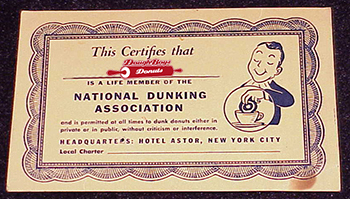

How do I make bakers want to buy my flour rather than Pillsbury’s, or any other company’s?
That was the question Levitt had posed to himself as soon as his company began to take off. By the time Phil came on board, DCA was a multi-pronged venture. After his doughnut machines started churning out his doughnuts at a record pace for wholesale to bakeries across the country, like any good businessman, Levitt had begun diversify, and a huge part of his revenues were brought in by selling doughnut mix and its equipment to bakers. The foundation of the house that Levitt built was flour, a rather general commodity. Other than the price, not much distinguishes one company’s flour from another.
The answer to Levitt’s question—how to make his products stand out from the rest—was marketing. Ingenious marketing.
“He started with giving merchandising services to a baker who bought from him,” Phil explained. “He offered him an advertising campaign and a marketing guy to go in and help move the products. And that’s why they hired me.”
Levitt was a Jewish transplant to the land of opportunity possessed of the characteristic, one might say stereotypical, talents of his people: business savvy, ambition, and in particular, flair for salesmanship that crossed over into the realm of show business. In another incarnation, he could have been a Hollywood agent for A-listers. Or a vaudeville producer.
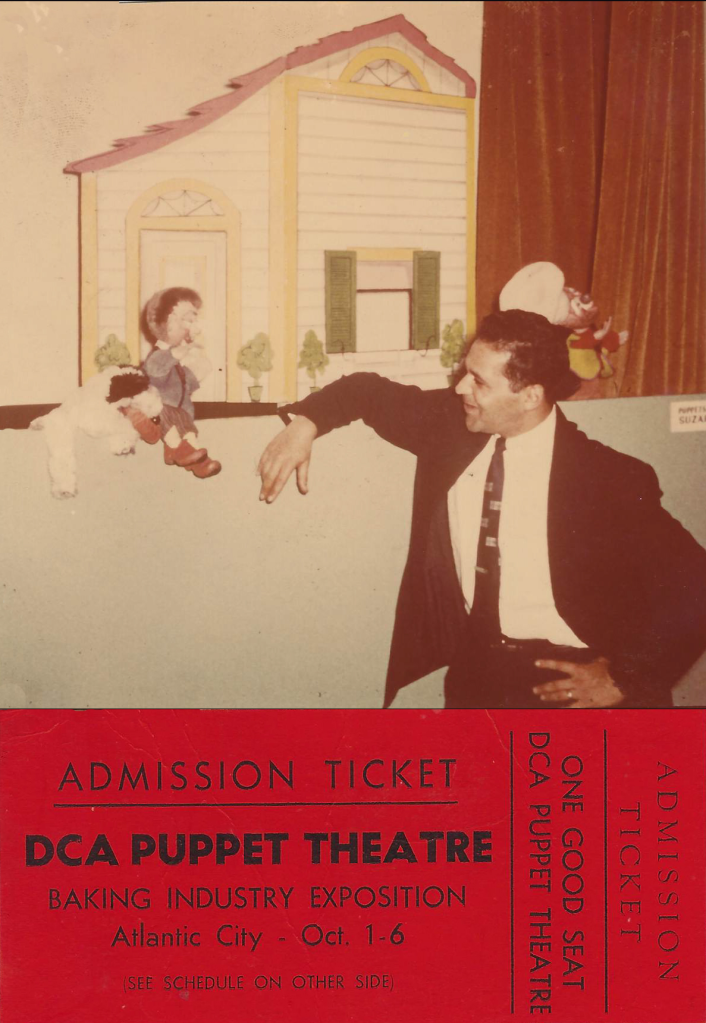
Phil had found the perfect fit for his particular knack for social and professional versatility. Since his hyperactive days as member of every club at Snyder High, Phil was a guy used to wearing many hats. His DCA position satisfied his craving for working on the creative end of sales, and it required him to take on many roles: PR flack, community liaison, promoter of children’s entertainment, including puppet shows, copy writer, publicist and schools ambassador of doughnut dunking.
As such, Phil’s eclectic position found him working closely with Clarabell the Clown, Howdy Doody’s sidekick on the wildly popular kids’ TV program The Howdy Doody Show, which aired from 1947 to 1960.
“I toured schools, and I traveled with Clarabell,” Phil recalled. “I’d give the schoolkids a dunker pin and a ribbon, and have them recite The Optimist’s Creed,” (which by now was everywhere). Get ’em while they’re young, as the saying goes. It was all part of the little ones’ indoctrination into the National Dunking Association. Its headquarters are reported variously to have been located at 50 East 42nd Street, 152 West 42nd Street and 393 Seventh Avenue—all addresses of DCA offices in New York City.
That’s showbiz.

Of all Levitt’s brilliant marketing schemes, without a doubt his most successful, all-encompassing and long-lived is the National Dunking Association. If you look up Doughnut Corporation of America on Wikipedia today, curiously there’s no entry. But Google National Dunking Association, and it’s the first thing that comes up.
“The National Dunking Association was a membership-based organization started by The Doughnut Corporation of America. It was established in the 1930s to help popularize doughnuts in North America,” the Wikipedia entry reads. “At its peak, the association claimed millions of members across more than 300 chapters. Members included famous actors, athletes, political figures, and people of all ages.”
With scope of his duties belying his simple job description of marketing manager, Phil fit right in, giving himself an impressive, if tongue-in-cheek, title: “I called myself national secretary of the Dunking Association. I used any gimmick I could. It was the world I was in. They were almost con men—Yiddish Damon Runyan-type guys. When they sent me to a town I went right to the baker’s local television station or the local advertiser in, for example, Syracuse, New York, and I’d say, ‘Well, I’m here representing Dugan Bakery, and because I’m the national secretary of the National Dunking Association, I’m gonna initiate all the public school kids into it.’ They’d say, ‘Gee, that’s wonderful.’ “
Then Phil used the classic pitchman’s opener: ” Tell you what I’m gonna do …” Yes, he did. ” ‘I’m gonna get Clarabell the Clown from Howdy Doody to come in.’ ‘Really? You can do that?’ I would call Bert Nevins at the office and say, hey, we need Clarabell out here.” Nevins, a star of the DCA marketing team and “vice president” of the National Dunking Association, was a font of zany promotional ideas who would be remembered in his 1966 New York Times obituary as the man who got Mr. and Mrs. Dwight D. Eisenhower to dunk doughnuts at a presidential campaign reception.
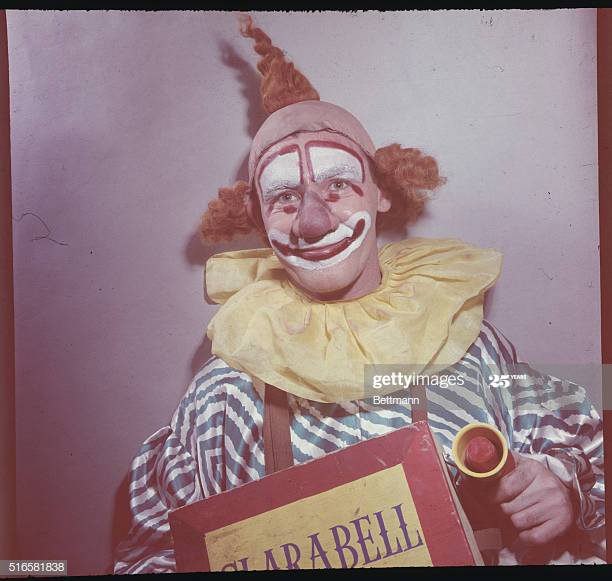
‘Well, I didn’t know who the hell Clarabell was. They hired somebody and dressed him up in a clown suit,” Phil said. “I brought that guy in and took him to an assembly for the kids in the grammar school and they loved it. I’d have the kids join and give them Dunking Association membership cards, aprons, pins and a comic book about doughnuts. We really put on a show.”

At one point, Phil got angry with them, because he went in and set up an assembly to promote doughnuts and some company guys started giving out Hostess cupcake samples instead. “I said, ‘Wait a minute. You guys are supposed to be selling doughnuts.’ “They said, ‘Yeah, but we can’t get crowds like this together. This is terrific.’
“It was spin. And, boy, did it work,” Phil enthused. “And it was all done under the sponsorship of the local bakery. So it was a goodwill service that the baker was delivering to the community, but I was doing it for the baker, which in turn obligated the baker to buy DCA’s flour. When these large bakers like A&P bought flour from DCA, then they’d need the equipment, which ran a couple hundred thousand dollars “
Levitt’s company produced its doughnut mix and doughnut manufacturing equipment in the historic mill town of Ellicott City, Maryland, right near Aberdeen Proving Ground, another of Phil’s old stomping grounds, where he trained in the Army. “I went to Ellicott City with the USO for dances. There have been flour mills there since the Revolutionary War,” thanks to its 180-foot elevation and abundance of waterfalls from the Patapsco River, the banks of which were the perfect location for the grain-processing plants.
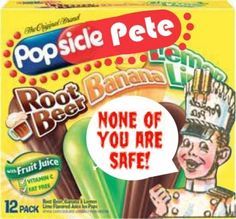
DCA sold its doughnut mix to all the major baking companies in the United States, like Bond Bread and the mammoth Continental Baking Company, And the competition was stiff, with DCA vying for business with two major competitors: Pillsbury and another company nobody has heard of anymore, the Joe Lowe Corporation. Joe Lowe’s, a bakery and ice cream supply business famous for acquiring the patented Popsicle (an actual trademarked invention) in the mid-1920s and the relentless promotion of its ice cream on a stick with a chocolate covering via an eccentric comic-book character named Popsicle Pete. Joe Lowe’s also had a strong share in sales of baking ingredients.
“These doughnuts companies had multistate distribution and sold flour to bakeries by the carload,” Phil said. “That represented thousands and thousands of dollars, so Pillsbury and DCA and Joe Lowe were all competing for that order. So this little stuff I did gave Doughnut Corporation an edge.”
“Little” is hardly an accurate description of the National Dunking Association’s vast reach. It was both fictional and very real, inclusive through wide-ranging publicity and promotion, kind of a common man’s Mensa. And it boosted sales across the whole company, intertwined not only with Mayflower Coffee Shops and doughnut mix and equipment but with all the many other tentacles of DCA’s business that spread their grip across America.
“Members were encouraged to eat doughnuts using the Official Dunking Rules, a step-by-step method outlined by the organization,” the Wikipedia entry continues. “The lighthearted rules referred to dunking donuts as a sport and instructed members to break their donuts in half before swishing them rhythmically in coffee, cocoa, tea, or milk.”

‘Doughnuts are a food that has rarely been taken seriously by the media,” Jan Whitaker observed in the popular blog Restaurant-ing through history. After encountering loads of silly stories about doughnut holes and dunking I have decided the reason is that throughout the last century the doughnut industry was amazingly successful in promoting its products, often through humor. Most of what appeared in papers and magazines was the work of publicity agents for the manufacturers of doughnuts, equipment, and mixes.”

Levitt’s doughnut machine had become a marketing machine, capturing Americans’ fun-loving nature with whimsical rituals, traditions and icons, scores of festive doughnut-centric events and dunking contests held across the country, and a star-studded cast of mascots and spokespeople. The name of one character in a cartoon-illustrated story DCA created was Ima Dunker.
Danny Donut, the stalwart symbol of Mayflower Coffee Shops, was Dunkin donuts became dunkin it’s a testament to the power of the dunk.mmmmmmmmmmmmmmmmmmmmmmmm

Yep. the doughnut-loving cop has been around for ages, as evidenced by the cover of the 1946 comic book Don’t Quarrel—DUNK! The book would also suggest that DCA had its finger on the pulse of a great American pastime with the power to bring harmony among those with irreconcilable differences.
Sure, the corporate guys were cool with that. It certainly didn’t hurt business.

Rare book collector Ian Brabner hit the nail on the head in an article about the comic book for his online catalog of rare American manuscripts and visual ephemera titled “The Strange History of Dunking Donuts.” Brabner observed, “Being laid out upon the very pages of this 1946 booklet, there seemed to be a blueprint strategy to commodify, and profit from thereof, the taking of the lowly donut and dunking it into a random beverage as a culinary experience of indeterminate pleasure.”
Brabner mentioned The Doughnut Corporation of America in the same vein, when he wrote about how, in 1944, two years before Don’t Quarrel came out, DCA “had issued (pseudonymously?) You Said a Mouthful, a booklet whom’s narrative, loosely interpreted, seemed to suggest that patriotic doughboys should patriotically dunk their patriotic donuts into their patriotic coffee.”

Leave it to the boys at DCA to appeal to liberty-loving Americans’ sense of patriotism to promote the fine art and decorum of dunking doughnuts. And at the height of World War II. One secret to success in advertising: Timing, timing, timing.
An Official Rules for Dunking pamphlet put out by DCA, features Uncle Sam in mid-dunk on the cover, a body of illustrated dunking techniques and a spirited appeal to their fellow citizens titled Dunking and Democracy: “Dunking is fun, yes. Everyone acknowledges its grand contribution to good humor, good spirits, and good fellowship. There’ something about dunking that has a wonderful appeal … the type of good-natured appeal that the late, beloved Will Rogers had.
“The National Dunking Association recognizes this fact. We sincerely believe that by encouraging the act of dunking, we will be doing much toward keeping alive America’s priceless sense of humor in these troubled times.
Dunking doughnuts as your civic duty to maintain a sense of humor during trying times. Ingenious. It boggles the mind to think what these guys could have pulled off in the age of the Internet.
“Dunking is the American way, the democratic way,” the pamphlet goes on. “It is the great equalizer that puts all Americans on a level footing—a footing of friendship and typically American good humor.”
Levitt and his cohorts Levitt and his cohorts had the same flair for the dramatic and flair for the dramatic and promotional savvy as the Jewish movie moguls of his time. keen sense of eternal wisecracking sense of irony Keeping your sese of cause than themselve vertarans and who faught red courrge of communism
They were all brethren, these Jewish immigrants who how immigrants like levitt and the scions had such an uncanny sense for what Americans wanted
And DCA was in a unique place to push the most egalitarian of treats
greater than themselves Americanness than sense of humor

Finally in the mini-treatise Dunking and Democracy, members are encourage
as the great equalizer reads especially for a cause that was greater than themselvesWhat better liberty push doughnuts and the decorum communal experience as the Cold War World War two veterans Koria Levitt and his cohorts had the same flair for the dramatic as the Jewish movie moguls of the tame with whom they shared easton How many people actually greeted each other with the sign there We’re in this together and we’re still fun. We’l never lose our sense of counterpoint to the Nazis fascist heil, Hitler salute.
{also ww I he came before and got going during WW I ipad writing thoughts the one course I took in high school that I could pass and be with the girls – typing it’s a great skill for me ya know a lot of guys can’t exist in the world because they can’t handle the keyboard im very good on it
Flour was the foundation, doughnut mix house that Levitt built along with the nation itself, through war and peace, one booming enterprise at a time, realizing yet another American dream stories that are the substance of the first half of 20th-century U.S. history.
*******

Under the heading “Leadership” Wikipedia lists some of the famous men who served as “president” of the National Dunking Association: Two-time Oscar winner Jack Lemmon, Red Skelton, Joey Bishop, future Tonight Show) icon Johnny Carson and Jimmy Durante, beloved singer, pianist, comedian and actor with the gravelly Lower East Side accent and signature schnozzolla, an Italianized version of schnoz, American Yiddish slang for “big nose.” In Steubberg’s The Donut Book, an entertaining collection of trivia about the doughnut’s place in civilization, Levitt’s granddaughter mentions that Durante even worked up a routine about doughnut dunking.

Red Skelton 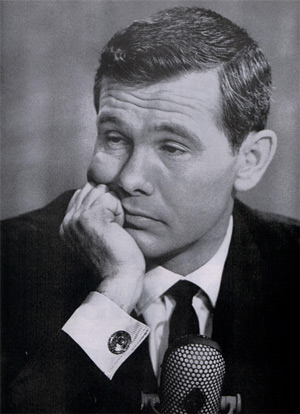
Johnny Carson 
Joey Bishop 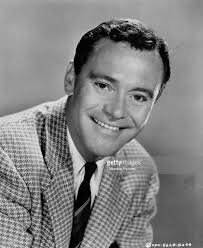
Jack Lemmon 
Jimmy Durante
“DCA wasn’t a national advertiser,” Phil pointed out. “But when they planted photos in newspapers and magazines across the country of these celebrities dunking doughnuts, it was the best publicity money could by.”

Dazzling star of stage and screen Zero Mostel, Fiddler on the Roof‘s quintessential Tevye on Broadway and also renowned for his role as Pseudolus in A Funny Thing Happened on the Way to the Forum, on Broadway and in the movie, was a shoo-in for membership in the National Dunking Association. Because Mostel dunked a giant doughnut into a giant cup of coffee (so unmanageable he needed help from a lovely assistant) in the aforementioned film, Steinberg recounts, “He was judged by the Donut Institute ‘the man most likely to succeed in keeping his toga dry while dunking.’ ” His comment on the honor: ‘Sic crustulum friat, or, translated from the Latin, ‘That’s how the doughnut crumbles.’ ”
It says it all that even luminaries with gravitas played along.
DCA flaks were so good, they enlisted prominent public figures like Paul V. McNutt, an American diplomat and politician who served as the 34th governor of Indiana, high commissioner to the Philippines, administrator of the Federal Security Agency, chairman of the War Manpower Commission and ambassador to the Philippines; and groundbreaking modern dancer and choreographer Martha Graham, who created 181 ballets and was the first dancer to to perform at the White House, travel abroad as a cultural ambassador, and receive the Presidential Medal of Freedom with Distinction.

Steinberg puts forth other tales of the inception of doughnut dunking in her book, however. “Some say the first to dunk were Baptists called the Dunkards,” Steinberg reports. Another claim has the trend starting with Civil War soldiers who dunked hardtack—a saltless hard biscuit, bread or cracker—in their coffee.
marketing maven makes his mark
In any case, as the lighthearted, communal practice of dunking donuts became fashionable, art, and all-American entertainment, imitated life.
In his 1942 musical This Is the Army, Irving Berlin “romanticized the doughnut … with a soldier who loses his heart at Broadway’s Stage Door Canteen and eats his way through some anxious waiting: ‘I sat there dunking doughnuts till she caught on,’ ” Taylor mentions in Smithsonian Magazine.
One school of thought holds that the very first doughnut dunker in movie history was Groucho Marx, who walks by and dunks his doughnut in a bystander’s cup of coffee in 1933’s Duck Soup. But there’s no room for debate over which classic film features the most famous doughnut-dunking scene in movie history: “Doughnut-dunking’s an art,” proclaims Clark Gable as he demonstrates for his beautiful co-star, Claudette Colbert, in 1934’s It Happened One Night. “It’s all a matter of timing,” Gable’s character insists.
By the Phil was immersed in the business, Levitt’s Optimist’s Creed had inspired “The Donut Song,” a lively, upbeat ditty for youngsters recorded by the homespun and jolly American folk singer Burl Ives, of Rudolph the Red-Nosed Reindeer fame.
All this is but a snippet of the impact doughnuts were having on the culture. Which is to say, Phil couldn’t have come along at a more perfect time in history to pitch doughnuts to the American populace.
“When I got to DCA, I spent about two to three years working with bakers throughout the industry,” Phil said. “I worked at all the major bakers and learned everything I needed to know about that environment. While traveling nationally, I had to learn how to promote and set up campaigns and create budgets and make myself useful to the baker, and I did that in a whole variety of innovative ways. I developed a very good reputation in the DCA sales force. The bigwigs heard about my success setting up promotional contests and promotional campaigns, so they really clamored for my services.”
Here’s a fun fact about the baking industry in the United States: It’s very German. As immigrants did, German Americans cashed in on the rich and accomplished tradition of their forebears who gave the world the strudel. (The name comes from the German word for “whirlpool” or “eddy.”)
Levitt came into his own in the 1930s. History has well recorded the tidal wave of anti-Semitism that was washing over Europe and much of the rest of the world. The United States was no exception. Levitt’s family had made it out of Russia. He’d tried 13 times to make his doughnut machine. He worked around bigotry with his usual aplomb.
“He would always brag about how he had the goyish people running the business for him,” Phil remembered. “That’s why he hired all these Irish-American guys as salesmen. “The German bakers were very prejudiced. They wouldn’t buy from a guy like him but they would buy from a WASPy-looking guy like Jerry McCarthy or Jack Lemmon.”
That would be the father of Jack Lemmon the actor who went on to win two Academy Awards and star in more than 60 movies, not to mention his stint as president of the National Dunking Association. Jack Lemmon senior was one of DCA’s top national salesmen. His famous son would visit DCA headquarters often because he was very friendly with Adolph Levitt’s son David.
“Jerry McCarthy was over 6-foot tall, blond, blue-eyed. They were always looking for an edge at DCA, and they were very clever,” Phil recalled. “McCarthy was in charge of national accounts and he could open doors all over in the baking industry in America that was staffed and owned mainly by a lot of German Christians.”
It made Phil’s rise to a powerhouse in the DCA sales force all the more impressive. If there’s one quality that served Phil invaluably in his success at DCA, it was yet again his social versatility. He was a guy who was rarely a fish out of water, and if he was, he dove in headfirst.
“I was short and Jewish and I grew up in a Christian Jersey City nub environment with all those Irish kids. I have that kind of chameleon-like personality,” Phil said. “I could work and be comfortable in the WASP community. They couldn’t stereotype me as a Jewish guy and they didn’t want that culture. It’s just like I did very well with shiksas but my mother never knew it. So I was really living a dual life.”
donut drive-thru dj: the perfect pitch
Paul Kistler was one such baker with a Teutonic background. Founder of Kistler Baking Company in Akron, Ohio, he was an adventurous entrepreneur, self-made millionaire and perfect role model for young up-and-coming Phil Ball.
Kistler was a Jersey boy like Phil who grew up in Bergen County, migrated to Akron and started his empire buy providing doughnuts to rubber companies with household names like B.F. Goodrich Company, the Goodyear Tire and Rubber Company, and the Firestone Tire and Rubber Company. In a city that had been the leading rubber producer in the United States since the late 19th century, earning it the nickname Rubber Capital of the World, Kistler’s business bounced. By 1950 more than 130 different companies manufactured rubber in Akron, employing 85,000 workers.
“He wound up with 90 routes servicing doughnuts and pastries and all that stuff to the factory workers of Goodyear and Firestone,” Phil said. “He bought equipment from DCA that came up to about $100,000.” It was the 1950s. Not only were factories teeming north of the border, they flourished, with blue-collar workers still building an American dream for their families making excellent wages. As always the automobile was integral to Americans’ way of life. The city that led the pack in tire production could not have been a more fitting place for a young marketing whiz to earn Kistler’s esteem by having a promotional brainstorm around customers buying doughnuts from the comfort of their own cars.
“When I got to Akron, Ohio, at this point I’m a 26-year-old kid,” Phil reminisced. As always, he had George Simoni, the real marketing muscle at DCA, in his corner. “Simoni said to Kistler, ‘Don’t worry we’re sending a top-notch guy out to help you on the opening – Ball he’s really a genius. I mean, they would really butter up my reputation. The job was so exciting because I always got into new stuff.”
On his first encounter with the driven middle-aged businessman with his sights set on expansion, Phil didn’t have a heck of a lot to work with: “So Kistler looks at me and says, ‘What the hell are you gonna do for me?’ I had no budget. I had been given a stellar reference, but no direction about what to do,” Phil said.
Necessity is the mother of invention. Kistler has just finished building a plant attached to one of his bakery-coffee shops and had great expectations for the grand opening. Phil stepped up at the perfect time. “I said, ‘Gee, you’ve done a lot of building here,’ and he said, ‘Yeah. Aah, the damn contractors are slow, and I said, ‘Who’s the contractor?’ He gave me a name and I called the guy: ‘Hi. I’m in town to help Paul with the grand opening.’ “He said, ‘Yeah, boy, I’m working hard on that deal.’ I said, ‘Well ya know, we have to do something to show Paul our gratitude. We’re gonna take a newspaper ad out. I assume you’re gonna want to be a part of that ad.’ The contractor didn’t miss a beat: ”You’re damn right I am!’ “
Phil mad five or six phone calls like Phil scared up enough money to I get a full-page ad in the Akron paper. “When I showed that to Kistler, he said, ‘You did this?’ I said, ‘Yeah .’ All of a sudden he warms up to me and says, ‘Come on. I’m gonna show you around the bakery.’ So he takes me, he’s got his arm around my shoulder, and he’s walking through and we get to one area and he says, ‘You see this? This is revolutionary.’ I said, ‘What do you mean?’ He said, ‘I’m gonna have cars drive through this window and we’re gonna hand doughnuts out through the window.’ “
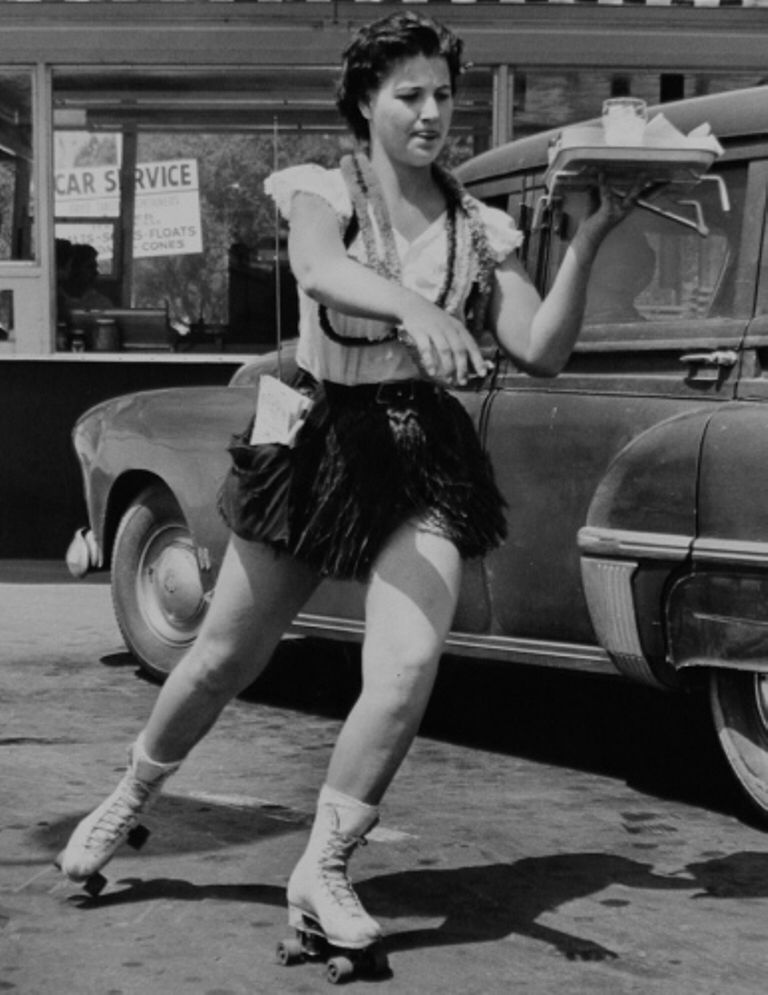
Now everybody knows, from film and TV shows, how popular drive-ins—those movies, an ideal haven for necking teenagers, and restaurants, with their perky, scantily clad female carhops on roller skates—but this was the first time Phil had ever heard of a drive-through doughnut shop. And he was in the business.

have been the first. The Donut Hole,
in La Puente, California, took the
concept to new heights in 1963.
Whether Kistler’s was the first bakery with car window service, as Phil supposed, is impossible to know. The first reported drive-through, or drive-thru, as it came to be known, grew out of a California franchise of the carhop Pig Stand, a Texas drive-in barbecue chain serving pulled-in 1931. But drive-throughs were still a curiosity two decades later. They did not replace drive-in service at fast-food joints like McDonald’s in America until the 1970s. In any case, Kistler’s drive-thru coffee-and donut service was in the forefront of paving the way, as it were, for the trend to develop in bakeries.
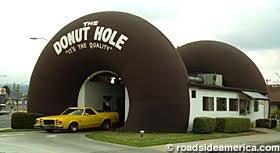
In 1962, The Donut Hole opened in La Puente, California, taking the concept to a whole new level—vertically. The architecture of this roadside attraction, one of the most photographed doughnut shops in the United States, is all the advertising the . Customers enter and exit by driving their cars through giant doughnut holes more than two stories tall, picking up their fare from counters along the way. Nowadays, with drive-thru banks and liquor stores, among other consumer goods and services (let’s not forget the ever-popular car wash), doughnuts are still living up to their 1934 World’s Fair reputation as the hit food of the Century of Progress well into the 21st century. In 2018, Dunkin’ synced its drive-thru with digital technology, introducing its first-ever drive-thrus exclusively for those that order ahead using the DD Perks app. The locations are also integrated with digital kiosks so customers can order with or without the help of a Dunkin’ crew member, taking humans out of the process altogether. And it all started in Akron with a visionary named Kistler.
“It was the first drive-thru,” Phil insisted of Kistler’s brain-child. “And when Paul explained it to me, I said, ‘Hey, that’s terrific. When does this open?’ He said, We’re gonna have the drive-thru for the grand opening.’ So I said, ‘Wait a,minute. for the grand opening? How ya gonna let people know about it he said, We’re gonna get radio spots.”
Radio spots. Hmmm. One great idea deserves another.
“Well, who ya talking to?” Phil asked. “So he gave me the name of the radio salesman and I called that guy. And I said, ‘Look, ya know Paul is taking a radio spot. You gotta be good to this guy because he could become an ongoing advertiser with that drive-thru.’ ‘He said, ‘Yeah I didn’t think of that.’ “
While TV was gradually replacing the radio as the hearth of the American home, the Golden Age of Radio didn’t end officially until 1962. Commercial radio broadcasting had been a lucrative market since the 1920s, And those same folks who thrilled to the heroes on suspenseful radios cliffhangers, laughed at radio comedy and sang along withe the best of them who crooned and blasted out of their tubes, and who’d hung on FDR’s every word during his wartime fireside chats, had a new hearth to gather around, and it was mobile.
“In those days everybody listened to their car radios when they drove,” Phil pointed out. It certainly wasn’t their CD players. And DJs were well on their way to becoming the same public personalities and friendly voices in the ears of the citizenry that they remain today.
“Why don’t you do this,” Phis said to the Akron radio adman. “Why can’t you get one of your disc jockeys in the window when the drive-thru opens and let him.” The radio station was sold on the idea. And the DJ loved it. He’d hand out the doughnuts while on the air and ask the driver for his name and chat a little. Obviously a plug for how delicious Kistler’s doughnuts wouldn’t hurt either.
“We had cars line up for a mile trying to get through the drive-thru to buy doughnuts,” Phil said. “At that point Paul Kissler absolutely loved me.”
the silent generation
In Paul Kistler, Phil had earned the respect and affection of yet another older successful man, who naturally became his mentor and spiritual benefactor.
“Kistler lived like a baron in Akron,” Phil remembered. He did more than take Phil under his wing, he took him into his home on an estate he’d bought from the head of the Goodyear company, which got its start in 1898 selling bicycle and carriage tires, horseshoe pads, and poker chips out of a converted strawboard factory on the banks of the Little Cuyahoga River in East Akron. The company maintains its global headquarters in Akron today and reports $20 billion in sales while its name continues to memorialize Charles Goodyear, who died penniless after inventing vulcanized rubber in 1844.
Kistler also took Phil to his country club. These two buddies hung out. “I had that relationship with all the senior men I ever knew going back to Louie Furst in the fish store,” Phil observed. “They were always very skeptical of me at first. They knew that I was a fresh kid, but then when I did something they admired, they became very paternalistic and close. They become father figures. It happened with Louie in the fish store and it happened with Paul Kistler. I was like his son.”
One thing Phil has a keen memory of he and Kistler doing together is watching the landmark Army-McCarthy Hearings on television.
The hearings, the first televised political proceedings in U.S. history, marked the culmination of one of the darkest and most infamous periods of our country’s political past.
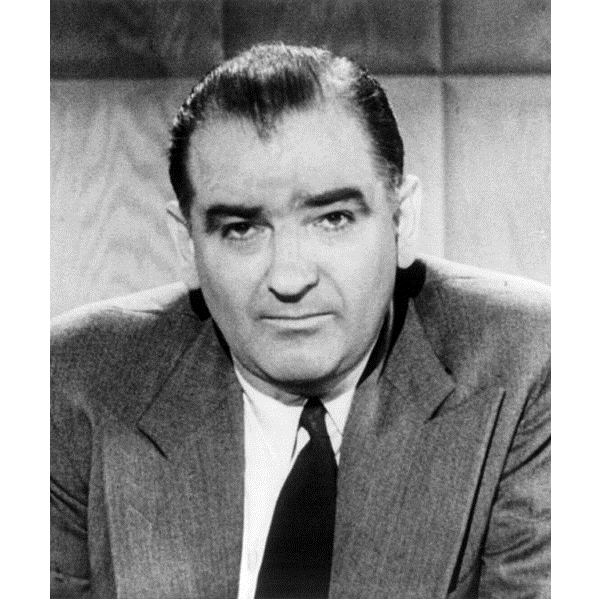
U.S. Sen. Joseph McCarthy, elected in 1947, was a thoroughly undistinguished congressman from Wisconsin until 1950, when he gave a speech to the Republican Women’s Club of Wheeling, West Virginia, in which he brandished a piece of paper on which he claimed to have a list of 205 Communists, including members of a spy ring, that had infiltrated the U.S. State Department. Overnight the loser junior senator who had been dispatched to a remote outpost of America to give a stock fundraising speech for the Republican Party on Lincoln Day had made headlines. McCarthy’s secretary said the senator became “almost intoxicated” by the press he was getting.
McCarthy’s speech that day amounted to a brilliant, if completely unsubstantiated, treatise about the threat of Communism—with a capital C, as in the Marxist-Leninist ideology of the Soviet Union—not from outside over in the reviled U.S.S.R., but from the dreaded “enemies from within” the United States. It would alter his fate and set him on a path to becoming one of the most infamous fearmongers in U.S. political history, and one of the canniest exploiters of the Red Scare in the United States in the 1940s and 1950s.
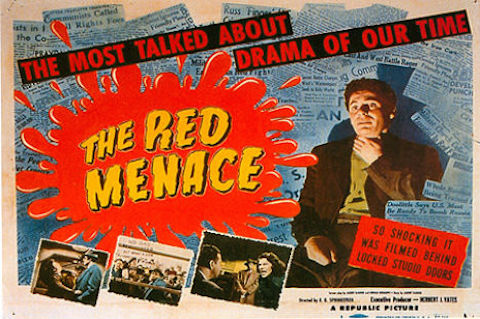
looks like a parody of the times. But “The Red Menace” was a
gravely serious film in 1949 that, as the online movie-review
website “Rotten Tomatoes” quips, “plays like a merciless
lampoon of the genre when seen today.”
McCarthy used his limelight and the dread of the times to great effect in his reign of terror over the next four years. His ensuing “witch hunts,” as they came to be known, for Communists from all walks of life—government, science, academia, Hollywood, artists, playwrights, novelist, activists, lawyers and most notably the prominent and the gifted—destroyed many lives and ruined many careers before the zealous and unhinged senator’s downfall.
“I thought McCarthy was an autocrat and just the rise or the continuation of the isolationism that was prevalent in the United States the ’30s,” Phil said.
It’s impossible to know the exact number of McCarthy’s victims. Hundreds of people went to prison, and some 10,000 to 12,00 lost their jobs. The senator, heading up the Senate Permanent Subcommittee on Investigations on his in consort with the House UnAmerican
His subcommittee held 169 hearings throughout 1953 and 1954. Of the 653 people called by the Committee during a 15-month period, 83 refused to answer questions about espionage and subversion subversion on constitutional grounds and their names were made public. Nine additional witnesses invoked the Fifth Amendment to the United States Constitution in executive session and their names were not made public. Some of the 83 were working or had worked for the Army, the Navy, the Government Printing Office, the Department of the Treasury, the Office of War Information, the Office of Strategic Services, and the Department of Veterans Affairs.
“I was very unhappy with the blacklisting of the Hollywood 10 is it and how the whole anticommunist movement was very destructive to democratic freedom n that sense I really felt he was a threat a bad threat,” Phil remembered.
And in the wake of this widespread damage came an even greater destruction: the erosion of our country’s core democratic principle: the freedom of speech. In many cases, simply being subpoenaed by HUAC or one of the other committees was sufficient cause to be fired. McCarthy’s anticommunist crusade led to at least two of its victims committing suicide.
You’d have had to live through it to have a visceral understanding of how tight a grip the fear of Communism had on Americans in this era. It earned Phil and his cohort, sandwiched between the Greatest Generation and the Baby Boomers, the title of The Silent Generation included men who had put their lives on the line fighting in the Korean War, which “containment” as evidence that made an everof the Soviet A
People are never their best selves in a state of fear. Fear breeds paranoia and irrationality.
Merriam-Webster’s defines McCarthyism as
It’s a paradox of political that the far left and the far right end up meeting up with each other at 180 degrees on the ideological circle. Josef Stalin was essentially a dictator having eliminated the more idealistic Trotskyites
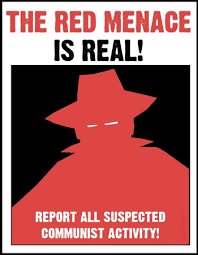
“I get unhappy with people on the fringes the fascist movement people on the extreme right and the extreme left I’m a person who lives in the middle and I always felt that the communist menace in the united states was overdone exploited by a lot of people for their own purposes,” Phil said.
When it comes down to it, there’s only one essential ingredient to fascism: victimhood. It’s losers with Hitler, a failed artist Stalin, McCarthy who likely would never haveIn an incident for which he would be widely criticized, McCarthy lobbied for the commutation of death sentences given to a group of Waffen-SS soldiers convicted of war crimes for carrying out the 1944 Malmedy massacre of American prisoners of war. McCarthy was critical of the convictions because of allegations of torture during the interrogations that led to the German soldiers’ confessions. He charged that the U.S. Army was engaged in a coverup of judicial misconduct, but never presented any evidence to support the accusation.[51] Shortly after this, a poll of the Senate press corps voted McCarthy “the worst U.S. senator” currently in office.[52]
The far-flung of
Anti-Red Russian spies
Senator Joseph McCarthy points to a map of the Communist Party across the U.S. before the Senate’s Permanent Subcommittee on Investigations in 1954
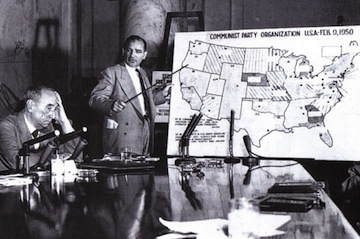
Army-McCarthy Hearings dominated national television from April to June 1954. Not until the Watergate hearings two decades later, which surely were to Americans, from so privy to In many ways these hearings were a testament to the power of television. The hearings were must-see TV in part because of McCarthy’s notoriety, and they proved taking public opinion in America got the bullying .
“This committee’s activities my well determine whether this nation will live or die,” McCarthy declared in one of many hyperbolic statements.
Other historians contribute McCarthy’s demise as much to the President Eisenhower who had finally and his own finally having enough.
And in the end, McCarthy’s elusive “list” of State Department commies, which catapulted him to prominence in the first place, turned out to be a chimera. The first person to call him on it was
He was censured by the Senate and though he continued to rail against, his reputation ruined. McCarthy’s drinking spiraled out of control. When he was pronounced dead in 1957, just 10 years the cause of death was listed as hepatitis, very likely exacerbated by his alcoholism.
“I remember at the World’s Fair in 1939 my father refused to go into the Soviet exhibit and he even turned his head. ‘Don’t look at it. They’re bad people,’ he told me,” Phil remembered. “I always disliked Stalin and Communism. American communists made me very unhappy I disliked them and I thought Americans who were sympathetic to the Communists were really narrow and dogmatic on the other hand I really disliked McCarthy and McCarthyism and I found that very frightening. I was delighted to see Mccarthy destroyed.”

While McCarthy’s timing when it came to any of Communist Party in the United States, it was way off. Communism — with a capital C — what force In a retospective article about the history of the
By the mid-1950s, membership of Communist Party had slipped from its 1944 peak of around 80,000[ to an active base of approximately 5,000.[32] Some 1,500 of these “members” were FBI informants.
The Cold War mindset created a domino effect of its own, triggering foreign policy missteps that will ripple with ramifications far into the 21st century. Along the unwinnable wars in Korea and Vietnam Soviet containment A disproved conspiracy allowing Pakistani the confusion allowed mujadeen to ris to power in the country his name was Osama bin Ladin, mastermind of the September So in some ways the
If there’s one thing the Cold War and McCarthyism has shown us it’s that not only are regular people state never their best selves in a state of fear, the U.S. government and its foreign policy are at their absolute worst. In a surreal turning of the tables, it was revealed that in the post-9/11 War on Terror interrogators followed the “communist” interrogation methodology used by the Chinese who sought to elicit false confessions to war crimes from U.S. prisoners during the Korean War at its prison at Guantanamo Bay in Cuba, also known as Gitmo. Shockingly, the only thing that was changed in the coercion strategy adopted for use at the Guantanamo detention and interrogation facility in 2002 was the title. It was originally called the “Communist Coercive Methods for Eliciting Individual Compliance.”
“What makes this … doubly stunning is that these were techniques to get false confessions. People say we need intelligence, and we do. But we don’t need false intelligence,” said Sen. Carl Levin, chairman of the Senate Armed Services Committee.
—
775 detainees have been brought to Guantanamo. Although most of these have been released without charge. It is considered by Amnesty International and other human rights organizations. Many, like were held without charges for more Democratica Presidents Barak Obama went As 2020, there were 40 men still incarcerated at Gitmo. Waterboarding.
fought on false intelligence CBS news revealed horrifying photos of abuse of Iraqi prisoners by U.S. solders at t Abu Ghraib prison outside of Baghdad.
You don’t spend nine decades on the planet without seeing more than your share of demagoguery and abuse of power. And you know an autocrat when you see one. Phil is hardly the only person to notice the stain of McCarthyism in more recent historical developments, namely the U.S. presidency of Donald Trump and Israeli Prime Minister Benjamin Netanyahu.
No president of the United States has come close to accussing his enemies of treason more than Trump, elected in 2016.
GOP political strategist Rick Wilson, writing in Rolling Stone
Robert mueller PI don’t think it will result in the downfall of trump I think it will uncover more of the duplicity and bad tactics that his group used to win the election just as impeachment was not possible for Clinton, I don’t think it will take place here hopefully we’ll just slide trump will finish this term and even if he gets a second term, we’ll overcome this
Whether we’re facing demagoguery in the 1950s or the 21st century, the future, by definition, is uncertain. Phil has never lost his spritely essence of Pollyanna, however. And let’s face it, the man who turned 92 on April 1, 2020, is not likely to change.
“I’m an eternal optimist,” he concluded. “I feel that essentially despite the authoritarian figures, be they Trump, Netanyahu, McCarthy or others, right will prevail. I believe in the biblical injunction about the wolf dwelling with the lamb. I always have an underlying feeling that the lamb will survive and not be destroyed by the wolf. I think it’s optimism that enables us to regenerate and re-propagate in spite of these destructive forces we’ve had in history, beginning with Satan. Humanism will prevail.”
continental coup

Of all the major bakers DCA and its competitors courted, Contiental Baking Company was the lodestone. In the third year of Phil’s employment at DCA I had developed a reputation of belief on the part of the sales force that’s when they brought me to continental because continental for them was the lodestone their real goal Continental was the largest baker in the world and they had never done business with Continental before so for me to help them hey had a salesman Jerry who was national salesyou got hired then the granulated sugar donuts you’re almost beingloand out to Contintental Elmer Samoni –sales manager Simoni ?? Jewish Sugarman rep and he called on continental for years they finally really liked this product and said hey this procuct is good enough for us to try the donut business and mccarthey said fine, I’ll introduce you to a kid who will give you leadership in introducing the product nationally that was me wsa this a coup for

Firmly ensconced as DCA’s Laison to Contintental Baking, Phil was now essentially working directly for Continental, even if his paychecks were cut by DCA. Cliff isaacson the donut guy – he adopted me and here he is director of a $400 million hostess cake division he ran twinkies and hostess cupcakes that was a big big Isaacson became the next in a series of mentors and father figures who took Hil under their wings during his youth and young adulthood.business nest to wonderbread, their cake division was their biggest division and isaacson it’s true he went to college but during the Depression he couldn’t get a job so he took a jo as a route salesman a bread salesman and he rose to become director of the hostess cake division he was a major executive and that’s the guy that jerry mccarthy brought me to meet because hostess wanted to go into the donut business but they didn’t want to do it without they wouldn’t hire their own guy and dca said well we got phil ball working for us he’s a marketing genius I can show you an ad they put me in as an executive with all their major executives – I had just worked for them for two months and they put my picture in this ad”They weren’t outright shysters,” Phil mused. “Of course not. they weren’t con men but they oveblew everything and they became a major company
you’ve got a picture there of the hostess doughnuts on flowers I would go to a bakery and we’re about to introduce doughnuts and he said, look, we gotta get this product into Kroeger’s and I said what’s the problem there? He said, do you know how tough it is to get to the bakery buyer in Kroeger’s? We have to wait two days to get an appointment with this guy and I said you know what you have to do is learn how to make yourself different why don’t you take a box of the hostess finer donuts and buy a bouquet of flowers and send it to the bakery buyer’s home addressed to his wife and they said Gee, could we do that? These were midwestern route salesmen and we did that and the guy called and said when are you gonna come in and see me? How do we get those donuts in the store? That’s why DCA liked me that was my job that’s what I hadda do I became very successful at it –
Well, one day Isaacson said, Look, Phil, We’re gonna introduce this product on the west coast and how ya gonna handle that in terms of your family and I said, Cliff, my family’s coming with me He said, “Okay, go work it out with DCA. So I went to Samoni, had a meeting with Samoni and Sugarman and Mccarthy and I said, well they want to introduce California, and I said, but I’m not gonna stay away out there for a month and he said, well what do you want to do, I said, You’re gonna have to send my family out there then they grumbled “nah we can’t afford that So I said, “Fine, you don’t need me They wound up, Phyllis and the kids, Jeff had not been born yet – I guess it was just Bobby and Ellen and Phyllis and we went to California, they put us up in hotels and we had a great time – we worked he West Coast for two months from San Diego to Seattle and ya know, traveled and had the family with me so it worked out very well and it really was a very good job but then we got back home but after a while, I had been doing that for 8 years – and I just couldn’t take the travel anymore and DCA because the management was all nepotism because of Sugarman Zenus bloch/block saoid you should be the advertising manager here Well, sugarman was a relative of the president there was no future I had to get out and that’s why I got out and went to Merrill
At one point continental said look phil we gotta introduce the donuts in California well I had to deal with samoni and his number 2 guy art higgins who replaced jerry mccarthy that was internal politics I had to deal with dca they got angry I said look I am not staying away over a weekend so he said alright you can always come home I’d have to leave on Monday and come back Friday but I’d never spend a weekend away so then I came to them and said look now that we’’re gonna introduce in california and I said I am not gonna stay out in california and spend a lot of time away from my family they said well that’s okay you can come home every other week is said nope, I’m not gonna do that they said what are you gonna do I said my family’s coming with me they looked at me and said, wait a minute that means we’ve got to pay for five people they sent Phyllis and the kids we stayed in motels they paid for the entire ting it was a great trip but at that point I had them I was the key guy and they were getting carloads of flour out of continental baking company so I really had them but then I didn’t oh I was in a very crucial position but I could never get anywhere in DCA because all the executives – nepotism
and it turns out that they had developed a new product now
they had a senior guy Stanley Anderson and I became his junior they wanted to expand his activities I was his assistant but at the same time they had developed a new product they developed a miniature product called a Donut Gem which was about the size of a half dollar, a little bigger, and the donut gem they turned into a 10-cent package of doughnuts andthat excited a lot of people – bakers, it gave the bakers a confection item like bakers used to sell two cupcakes in a package for a dime this they thought would really expand their product line and they hired me as one of the guys who would go out and help them market this donut gem because I had this marketing experience which they liked this guy sugarman was such a jerk I get very impatient at times with people I don’t respect – and he said to me – and he spoke in this high-pitched voice – “have you ever had any experience with miniature products and I looked at him and I said, “Yeah, my father had a candy store I used to sell Lifesavers.” He looked at me – nyaha haahh hahh {creepy, condescending chortle} “That was a joke?’ and I said, yeah it was a joke well I said that in an interview with him and the sales manager, Mr. Samoni [???] Samodi [???} was a very competent guy and he was impatient with for example I understand it wasecretary of the national dunking association it was part of my job in marketing as the promotional guy for DCA Wikipedia this is a real thing but yeah it was a marketing gimmick Fake News??? 12 years with DCA plus eversharp
liked me because he knew that I wanted to beDCA had a laboratory a laboratory run by a guy named Zenus/Xenus Block/Bloch [???} who was a Ph.D. in food technology I really liked him and I spent a lot of time with him and he a marketing manager and he felt DCA needed a marketing approach and the laboratory developed a granular doughnut that would hold granulated sugar that may not sound like a big deal, but powdered donuts you ate a powdered donut you got the powdered sugar all over your clothes a donut – called an old-fashioned donut that had kind of a fracture on top, a crinkle, with granulated sugar was very, very tasty and up until then when they tried to put a commercial donut into a box—a cellophane-wrapped box the sugar would break right down block/Bloch and his laboratory developed that and Mccarthy took it to continental and they loved it and they agreed to try it in a test market they had distribution in every market in the united states and they said we will not take that on unless we had a person to supervise it for us and McCarthy said, well I got the right guy I have Phil Ball and he brought me up for an interview with Cliff Isaacson, Continental’s national sales manager, and Ellis Baum, who was their national vice president these guys were giants in the industry And Baum, he was Jewish I guess in this Christian company kinda tough guy he said to McCarthy “So ball is the guy who’s gonna do it for us? And Mccarthy said, “He’s very competent, Ellis So Baum interviewed me with Isaacson and he said, well, so can you do a job for our company and I said, “Well , Mr. Baum, I can do a good job for you but I’ll tell you one thing, if you want me to do a good job, you’ve got to get me help and you have to give me good people to work with, otherwise I can’t do a good job and he laughed – they liked that and he said to McCarthey, “I think this guy’ll be good for us, Jerry put him on./ We’ll try. And that got us started. And they developed a package I was in there on the design of the package and it was a 49-cent box of donuts and we tried it on a route in Pateson, NJ and I drove on the truck with the driver and we developed a little rack and put it in 10 grocery stores and they sold right out it was a very tasty product and that started it from there we went to one market to two markets and I eventually to that product throughout the united states as a matter of fact when the product reached the West Coast, smoni called me in and he said, well ya gotta go to California now, the deal with DCA, see, DCA loaned me to Continental I was still paid by DCA but I worked for this guy Cliff Isaacson and I would go down to DCA once a week and report to them and then go back to Continental in Rye and travel around the united states every week I was on a plane but in those days I could leave la Guardia in the morning, fly to Memphis Tennessee work in Memphis one or two days, be back home the next night there were none of these hubs airlines were very, very efficient and easy to travel on so I was traveling nationally but I would never I said I will not stary away from my family over a weekend and they said, well, if you go to Omaha, we’re not gonna send you back and I said, oh yes you are cuz I had them I was the key guy on it Mccarthy would say, “Hey, go with this guy. McCarthy was my advocate. And Samoni would grumble about the budget and the amount of money but they were making a lot of money
– Levitt was a very, very intelligent man he sold prepared mix to the wholesale baker, people like Bond Bread, Continental Baking Company, Wonder Bread, although Wonder bread they had never had a doughnut line and that was the exception that was Continental was the finest baker in the world they had a great reputation –
I think I came more out of that TV program about the advertising agencies – Madmen that was my generation It’s kind of a fun job although it’s exhausting traeling with DCA “it was exciting” it became that you were workingfor continental on loand granulated sugar donut what happened was this they would not have taken that product on unless they had a merchandising specialist and DCA shrewdly offered me in that role saving them the investment of hiring somebody DCA said to them look we have this guy Ball who’s very good, very capable we’ll assign him to you full-time so I began to report to their sales manager a guy named Cliff Isaacson at their headquarters He was the national director of Hostess Cakes a wonderful guay and he was a wonderful mentor for me he was a significant guy in my life

CONTINENTAL BAKING COMPANY OWNED WONDERBREAD AND HOSTESS Isaacson wsa in charge of hostess cakes twinkies cupcakes and he was the one who pioneered bringing the new line of donuts in and I reported to him you worked on these granulated sugar donuts and you wnet traveling around with Clarabelle the clown prior to hostess what DCA did, ws because they were selling flout How do you distinguish your flour from Pillsbury’s flour flour is a commodity so DCA was the one company shrewd enough to add marketing to the flour – the marketing was free so a if a baker bought flour from the and you know bakers bought flour in carload lots and order of flour was a lot of money if the bakery –
Levitt it’s just fascinating to me this stuff is coming out as I’m working with you levitt hired through this jerk I worked for jerry sugarman all the executives at dca were family members they were all jewish immigrants who had come up to the point where they could work in the coporate world levitt through jerry sugarman hired burt nevins as a PR guy burt nevins is the guy – when miss America became famous in Atlantic City burt nevins developed Mrs. America at Palisades Park – which became a big, big deal burt would do all sorts of stuff when Kruschev to meet with Johnson … kruschev I’m almost sure nevins heard he would land at La Guardia nevins had a guy working or him who was a damon runyon character and he said to him ya know when Kruschev lands you’re gonna take a box of doughnuts and run out on the runway and try to hand him a box of doughnuts and I was at this PR meeting and the guy says, “But Burt, If I do that the FBI’s gonna try to lock me up.” And Burt says, “Ya idiot. That’s the point of this whole thing.” But they were serious about it, ya know?” Merrie that happened I was in a meeting and honest, they were all like Damon Runyon people “And they were very sincere in what I considered fantasy. They really made the absurdity come truehttps://www.google.com/search?q=kruschev+visit+to+united+states&rlz=1C1CHZL_enUS691US691&oq=kruschev+visit+to+united+states&aqs=chrome..69i57.27330j0j7&sourceid=chrome&ie=UTF-8
Movin’ On up
Phyllis, though, and this was the beginning of problems in our marriage: I took that job without consulting her and she was very upset and my view because at that time cus I was the typical chauvinist kind of guy I thought, “What the hell do I haveto consult her for ? This is my career and that was the beginning of some turbulence in our relationship well, listen, we had an argument on our first date I should have been smart enough to know that there was a problem but I succeeded in getting a job traveling nationally but that was not easy on her and it was the beginning of my career y aknow it really was a very good job because I not only traveled nationally but ultimately it got me to Continental it got me to product introduction and in the next 12 years until I went to Merrill Lynch I really had a very good career in terms of self development and learning and maturing in the business world V: So how did you transition from the world of business to finance, was that and easy transition or was it a bit rocky or you felt, ah, I need a change or – how did that come about?
Among the many awesome perks of the GI bill you and Phyllis got a low-interest loan and bought a house: I knew I had to to get out of Jersey City Ellen and Bobby were born in Margaret hague hospital I knew I did not want to live nJersey city in a two-room warped walkup near the hospital I knew we had to get out of there out of Jersey City at that point I think I was new at eversharp or I may have gotten the job at DCA I was making enough money I said let’s get out of here I tolds Phyllis to find us a house either I told her to got to Bergen county or she went on her own and we got a garden apartment in Bergenfield and I loved that – right next to Englewood we stayed in that Garden apartment about 2 ½ years, then we bought a house in Englewood like a starter house it was 20,000 but we bought that on the GI bill of rights so I couls get in there I bought that house in Englewood probably about 1955 or 1956 you’re still a very young man you got a good job great salesman with a keen knack for salesmanship two kids house in Englweood by 27 years old first moved in with Phylis from herbies room were in a dumpy two-room apartment walkup in jersey city — garden apartment in Bergenfield btw that was a normal transition for a lot of young people at that point they would {stanard American dream trajectory) move out of an urban area into a suburban garden apt. that was very common in America
Eversharp as apart of their sales and merchandising team and I’m writing about that now and I’ll deliver a chapter to you about that Phyllis/
Phil married in 1952 (MAY: SEE PHYLLIS MARRIAGE/KIDS) Bobbie a year and a half later – December 1953 born that was one of my ambitions I wanted kids and she wanted kids we were very good that way btw we were terrific parents people used to compliment us on how good we were with the kids really in a lot of ways we were terrific with the children so by early ‘50s you already have one kid (see kids) Bobby’s now 65, ellen 63, Jeff 62 (61 ½) I remember when Phyllis conceived with Jeff she said I’m really gonna enjoy this kid this is my last and that became typical of the relationship there were an awful lot of things that she controlled – I had no control over and I would get angry, where I would say you have to collaborate – you can’t make these unilateral decisions she would make a decision and shut me out of the decision and that really annoyed me but I wanted to maintain the relationship and Phyllis becaome a full-time mom and housewife I guess when the kids came along yeah
when I couldn’t take DCA anymore because of the travel you know every Monday I had to introduce hostess donuts in every plant that continental had they had plants in every city in the united states and then if you went to a major plant in the united states and then if you went to a major plant for example in Chicago then you had to go out to all the little extension plants they had distribution extensions in Indiana in all the towns so I was always on the road an I thought I have wacky kids so my first wife was very unhappy about the travel I got more and more unhappy about the travel – Merrill this guy harry litters ???? said gee we really like you we’d like you to work for us I said well I really like you to can I make more money here can imake $25,000 he said, “25? You can make 40 so he said you’re gonna start now I’ll pay you $7,500 so I said wait a minute I make $15,000 he said, I know I’m gonna pay you $7,500 I SAID Waite a minute I can’t do that he said you gotta come in and prove yourself you’ll be up to $25,000 in no time that’s the way that generation saw it and at that point I wanted to get off the road it was in Bergen County it was a national company and everything I wanted and I took it and then we (stepped down a run temporary) Phyllis was very unhappy because then we had to cut way back — $15,000 down to 7,500 but that’s the kind of turbulence I went through all my formative years (move from the house in Newark to candy store) and that really led was a large part of the divorce but that’s all the stuff you go through because I would have done anything in order to get a better job, move my career that was just part of my psyche it ws a great history as I think back and I talk about it I get such pleasure out of it
I just loved that job so that’s really what that job was for eight years you knowI was then making $6,500 a year. I got a job offer from ward baking company continental’s competitor because they heard about me and they offered me $15,000 so I came to simoni and I said I really enjoy working for you but I can’t stay I have to leave and he said what do you mean you have to leave is said Look I have two kids ? – think we had three I said I can’t put them through college I can’t make a living her I gotta take an offer he said, no no wait I can’t get along without you he said I’ll match it so I said What? He said yeah so I want back to ward I felt bad cuz I had taken that job and I said to him “I’m sorry but I can’t take the job they matched your offer AN he looked and he said “wait a minute I know what leverage is you’ve got one helluva nerve I’m not gonna go any higher than 15 get out of her I really felt I didn’t know but the guy was very angry with me he thought I was trying to boost him to get more money out of hime but actually I never wanted to leave DCA and I didn’t want to leave hostess but that got me upt o a very high income level then
From its beginning, the Tydings Committee was marked by partisan infighting. Its final report, written by the Democratic majority, concluded that the individuals on McCarthy’s list were neither Communists nor pro-communist, and said the State Department had an effective security program. The Tydings Report labeled McCarthy’s charges a “fraud and a hoax”, and said that the result of McCarthy’s actions was to “confuse and divide the American people … to a degree far beyond the hopes of the Communists themselves”. Republicans responded in kind, with William E. Jenner stating that Tydings was guilty of “the most brazen whitewash of treasonable conspiracy in our history”.[67] The full Senate voted three times on whether to accept the report, and each time the voting was precisely divided along party lines.[68]
Truman, in turn, once referred to McCarthy as “the best asset the Kremlin has”, calling McCarthy’s actions an attempt to “sabotage the foreign policy of the United States”
https://en.wikipedia.org/wiki/Voice_of_America
The communists burned untold numbers of decadent western books and writings in the Soviet Union from the 1920s on, and several American libraries burned the works of supposedly pro-Communist authors during the McCarthy era.
Soon after receiving the chair to the Subcommittee on Investigations, McCarthy appointed J. B. Matthews as staff director of the subcommittee. One of the nation’s foremost anti-communists, Matthews had formerly been staff director for the House Un-American Activities Committee. The appointment became controversial when it was learned that Matthews had recently written an article titled “Reds and Our Churches”,[107][108] which opened with the sentence, “The largest single group supporting the Communist apparatus in the United States is composed of Protestant Clergymen.”
https://en.wikipedia.org/wiki/Margaret_Chase_Smith
August 8, 1974: Nixon delivers his resignation speech in front of a nationally televised audience. August 9, 1974: Nixon resigns from office. Gerald Ford becomes president.
recommended that McCarthy turn his attention to the worldwide encroachment of Communism outside North America.[132][133] In a June 1 speech, Flanders compared McCarthy to Adolf Hitler, accusing him of spreading “division and confusion” and saying, “Were the Junior Senator from Wisconsin in the pay of the Communists he could not have done a better job for them.”[134
former Reagan Administration Secretary of Education, summed up his perspective in his 2007 book America: The Last Best Hope:
The cause of anti-communism, which united millions of Americans and which gained the support of Democrats, Republicans and independents, was undermined by Sen. Joe McCarthy … McCarthy addressed a real problem: disloyal elements within the U.S. government. But his approach to this real problem was to cause untold grief to the country he claimed to love … Worst of all, McCarthy besmirched the honorable cause of anti-communism. He discredited legitimate efforts to counter Soviet subversion of American institutions.[154]
former Reagan Administration Secretary of Education, summed up his perspective in his 2007 book America: The Last Best Hope:
The cause of anti-communism, which united millions of Americans and which gained the support of Democrats, Republicans and independents, was undermined by Sen. Joe McCarthy … McCarthy addressed a real problem: disloyal elements within the U.S. government. But his approach to this real problem was to cause untold grief to the country he claimed to love … Worst of all, McCarthy besmirched the honorable cause of anti-communism. He discredited legitimate efforts to counter Soviet subversion of American institutions.[154]
WillIAM bENNETT former Reagan Administration Secretary of Education, summed up his perspective in his 2007 book America: The Last Best Hope:
The cause of anti-communism, which united millions of Americans and which gained the support of Democrats, Republicans and independents, was undermined by Sen. Joe McCarthy … McCarthy addressed a real problem: disloyal elements within the U.S. government. But his approach to this real problem was to cause untold grief to the country he claimed to love … Worst of all, McCarthy besmirched the honorable cause of anti-communism. He discredited legitimate efforts to counter Soviet subversion of American institutions.[154]
Historian Eric Foner writes that the Doctrine “set a precedent for American assistance to anticommunist regimes throughout the world, no matter how undemocratic, and for the creation of a set of global military alliances directed against the Soviet Union.”[3]
Acheson laid out the “domino theory” in the starkest terms, comparing a communist state to a rotten apple that could spread its infection to an entire barrel. Vandenberg was impressed, and advised Truman to appear before Congress and “scare the hell out of the American people.
he Truman Doctrine became a metaphor for emergency aid to keep a nation from communist influence.
the Soviet Union conducted its first atomic bomb test in 1949 and had built an impressive arsenal by the mid-1950s, doing so years before American experts had anticipated.
https://en.wikipedia.org/wiki/Strategic_Defense_Initiative
https://en.wikipedia.org/wiki/Dean_Acheson
https://en.wikipedia.org/wiki/Evil_Empire_speech
https://en.wikipedia.org/wiki/Emergency_Broadcast_System
https://en.wikipedia.org/wiki/Alger_Hiss
https://en.wikipedia.org/wiki/Smith_Act
https://en.wikipedia.org/wiki/The_Crucible
Symbolism and Similarities Between McCarthyism and The Crucible
The U.S. Congress, led by Senator Joseph McCarthy and the House Committee on Un-American Activities, conducted witch-hunts in search of Communist sympathizers. The accused had two options. They could refuse to testify and risk losing their jobs and friends. Or they could cooperate and accuse friends and colleagues of being Communists. At the same time, the Federal Bureau of Investigation, led by J. Edgar Hoover, monitored citizens’ activities, searching for “subversive” behavior.
https://en.wikipedia.org/wiki/Roy_Cohn
http://scarc.library.oregonstate.edu/omeka/exhibits/show/atomic/espionage/oppenheimer
https://www.amnh.org/exhibitions/einstein/global-citizen/mccarthy-era
Indeed, the Federal Bureau of Investigation amassed a file with almost 1,500 pages of information on Einstein’s allegedly subversive political activities.
“The current investigations are an incomparably greater danger to our society than those few Communists in our country ever could be. These investigations have already undermined to a considerable extent the democratic character of our society.”
https://en.wikipedia.org/wiki/Joseph_N._Welch
In the 83rd United States Congress, the subcommittee (now known as the Permanent Subcommittee on Investigations or PSI), under its new chairman, Joseph McCarthy of Wisconsin, greatly increased the number of investigations and number of witnesses called. His subcommittee held 169 hearings throughout 1953 and 1954. Of the 653 people called by the Committee during a 15-month period, 83 refused to answer questions about espionage and subversion on constitutional grounds and their names were made public. Nine additional witnesses invoked the Fifth Amendment to the United States Constitution in executive session and their names were not made public. Some of the 83 were working or had worked for the Army, the Navy, the Government Printing Office, the Department of the Treasury, the Office of War Information, the Office of Strategic Services, and the Department of Veterans Affairs.
https://en.wikipedia.org/wiki/Communist_Control_Act_of_1954
https://en.wikipedia.org/wiki/History_of_the_Communist_Party_USA
https://en.wikipedia.org/wiki/Lester_C._Hunt
https://en.wikipedia.org/wiki/Joseph_McCarthy
The value of the espionage is difficult to quantify, as the principal constraint on the Soviet atomic bomb project was a shortage of uranium ore. The consensus is that espionage saved the Soviets one or two years of effort.[263]
offering an alternative to the ills of capitalism during the Great Depression, the Communist Party of the United States increased its membership through the 1930s, reaching a peak of about 75,000 members in 1940–41.[14] While the United States was engaged in World War II and allied with the Soviet Union, the issue of anti-communism was largely muted. With the end of World War II, the Cold War began almost immediately, as the Soviet Union installed communist puppet régimes in areas it had occupied across Central and Eastern Europe. The United States backed anti-communist forces in Greece and China.[citation needed]
Hoover’s sense of the communist threat and the standards of evidence applied by his bureau resulted in thousands of government workers losing their jobs. Due to Hoover’s insistence upon keeping the identity of his informers secret, most subjects of loyalty-security reviews were not allowed to cross-examine or know the identities of those who accused them. In many cases, they were not even told of what they were accused.[27]
HUAC: At these testimonies, what became known as “the $64,000 question” was asked: “Are you now or have you ever been a member of the Communist Party of the United States?”[34]
One focus of popular McCarthyism concerned the provision of public health services, particularly vaccination, mental health care services, and fluoridation, all of which were denounced by some to be communist plots to poison or brainwash the American people. Such viewpoints led to collisions between McCarthyite radicals and supporters of public-health programs, most notably in the case of the Alaska Mental Health Bill controversy of 1956.[57]
on the premise that a commitment to violent overthrow of the government was inherent in the doctrines of Marxism–Leninism. Passages of the CPUSA’s constitution that specifically rejected revolutionary violence were dismissed as deliberate deception.[63]
In addition, it was often claimed that the party didn’t allow members to resign; thus someone who had been a member for a short time decades previously could be thought a current member.
https://en.wikipedia.org/wiki/Lavender_scare
A number of observers have compared the oppression of liberals and leftists during the McCarthy period to recent actions against suspected terrorists, most of them Muslims. In The Age of Anxiety: McCarthyism to Terrorism, author Haynes Johnson compares the “abuses suffered by aliens thrown into high-security U.S. prisons in the wake of 9/11” to the excesses of the McCarthy era.[150] Similarly, David D. Cole has written that the Patriot Act “in effect resurrects the philosophy of McCarthyism, simply substituting ‘terrorist’ for ‘communist'”
Miller later wrote: “The more I read into the Salem panic, the more it touched off corresponding images of common experiences in the fifties.”[168]
https://en.wikipedia.org/wiki/McCarthyism
https://www.history.com/news/bay-of-pigs-mistakes-cuba-jfk-castro
https://www.history.com/topics/cold-war/cuban-missile-crisis
fall of berlin wall:https://www.youtube.com/watch?v=zmRPP2WXX0U
https://www.history.com/news/ronald-reagan-tear-down-this-wall-speech-berlin-gorbachev
https://www.history.com/this-day-in-history/the-reagan-doctrine-is-announced
https://en.wikipedia.org/wiki/Army%E2%80%93McCarthy_hearings
https://www.kpbs.org/news/2020/jan/03/american-experience-mccarthy/
Nevertheless, by delegating responsibility for arms distribution to the ISI, the United States created an environment in which radical Islam could flourish. And, with the coming of the Taliban, radical Islam did just that.
https://www.washingtoninstitute.org/policy-analysis/view/who-is-responsible-for-the-taliban
https://www.cfr.org/timeline/us-war-afghanistan
https://en.wikipedia.org/wiki/Shaker_Aamer
Abu graib
{also ww I he came before and got going during WW I ipad writing thoughts the one course I took in high school that I could pass and be with the girls – typing it’s a great skill for me ya know a lot of guys can’t exist in the world because they can’t handle the keyboard im very good on it
Doughunt {???} corporation [of America] for example one of the early things they were one of the forerunners of settin up Dunkin’ Donuts franchises the $9.6 billion multinational coffeehouse and doughnut purveyor Dunkin’ Donuts (known as of 2019 simply as Dunkin’)
were family members of levitt and ya know he had two things, he had a good company and, as
DCA had some consumer products they had the Downyflake Frozen Waffle but their major business at that time they were a fairly large company I think they were doing about $100 million it’s interesting,





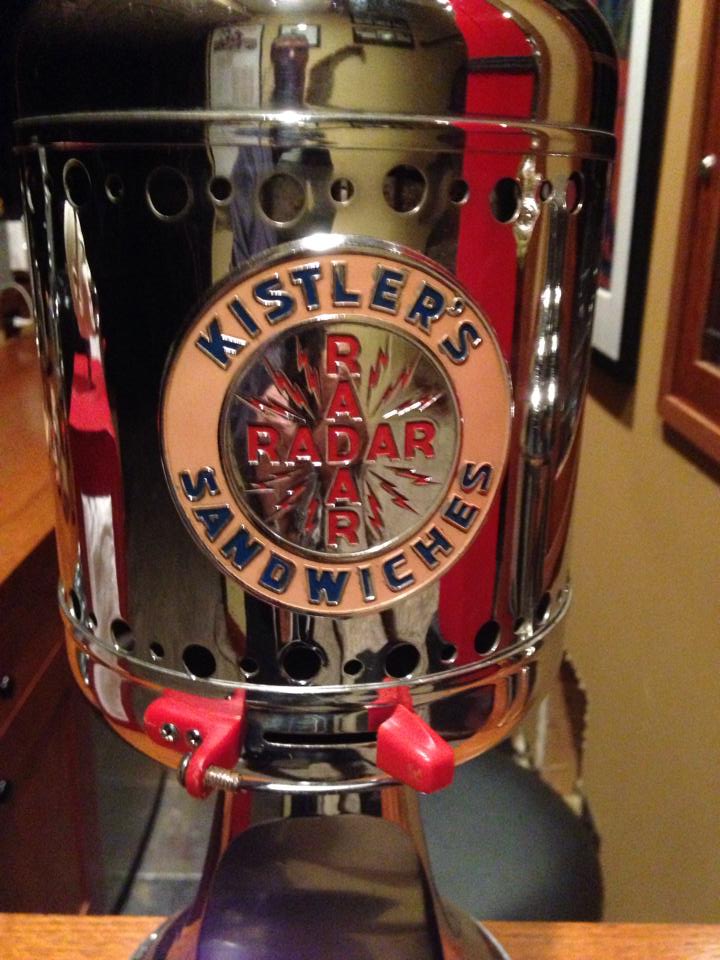

You must be logged in to post a comment.